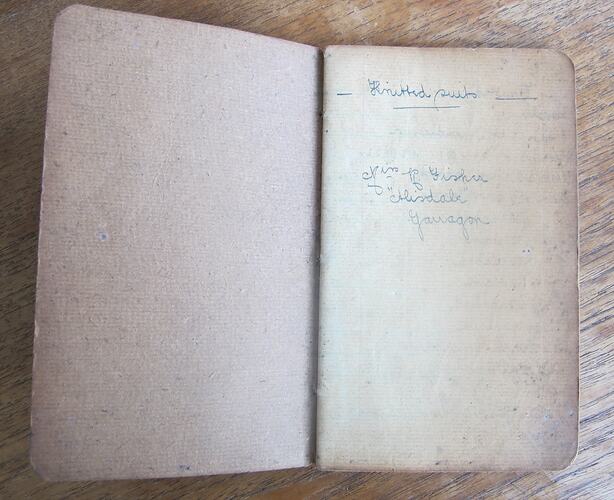Summary
Notebook of knitted suit patterns for use with the hand-powered flat-bed 'Preciosa' knitting machine manufactured by Wertheim (Germany) and retailed in Melbourne by Hugo Wertheim.
Physical Description
40-page notebook (counting both sides) with stiff black cover with textile finish. Stitch bound. First page is inscribed 'Knitted suits / R. Fisher / "Alisdale" / Yarragon'. Patterns are hand-written and have prices against them. Includes patterns for 'Child's Bloomers', 'Girl's Cap', Baby's open vest', 'Lady's cap', 'Collar for Jacket' and Lady's Singlet'. Personal names against some patterns indicate these were undertaken as commissions for particular people, such as 'Jean', Lynette' and 'Jimmy'.
Significance
The knitting machine provides a relatively rare record of a woman's cottage industry in rural Victoria in the early 20th century, as well as being a significant item of material culture relating to work for the war effort on the home front during World Wars I and II. The machine collection includes a range of parts, manuals, users' notes, two garments and a (digital copy of a) photograph of a garment being worn, providing a comprehensive record of how the machine was used and for what purposes, and how this changed over time as a second user worked the machine.
Knitting machines were enthusiastically advertised in the media in the early 20th century when this model was purchased, both for making family clothing and as a means of earning money. Hugo Wertheim advertised knitting machines as 'One of the most profitable means by which to earn a livelihood or supplement an income IN YOUR OWN HOME' (The Age, 4/2/1911, page 2).
The first hand-powered flat-bed knitting machine was invented by the American William Isaac Lamb in 1863. The machine enabled rapid production of tube and rib-knitted fabric. It knitted in alternating plain and pearl stitches, providing a ribbed effect with high elasticity that looked the same on both sides. The year after its invention, Lamb's flat-bed knitting machine was improved by another American, Henry J. Griswold. Sold under the names 'Climax', 'Crane' and 'Little Rapid', the machines were used in the cottage industry to make men's socks and children's stockings. With further improvements in the machine's design, circular-knit stockings could also be made.
In Europe, manufacturer Henri Eduard Dubied saw the flat-bed machine displayed at the World Expo in Paris in 1867. He bought the patent and began to make the machines, which he called the 'Trikoteuse Omnibus', in his own Swiss factory. By the end of the decade French and German manufacturers, including Laue und Timaeus (later Irmscher & Co., Dresden) were also making flat-bed machines. In 1888 the invention of the tubular cam by G. F. Grosser in Markersdorf allowed heels to also be knitted by the flat-bed machines. Later developments facilitated the production of patterned goods and the use of an electric motor.
The Lamb Corporation remains in business to this day.
More Information
-
Collecting Areas
Working Life & Trades, Sustainable Futures, Public Life & Institutions, Clothing & Textiles
-
Acquisition Information
Donation from Raema Edgington
-
Date Purchased
-
Retailer
Hugo Wertheim, 294-296 Bourke Street, Melbourne, Victoria, Australia, 1910
-
User
-
Inscriptions
Extensive
-
Classification
-
Category
-
Discipline
-
Type of item
-
References
German Hosiery Museum, [Link 1] accessed 14/6/2012 Wonseok Choi, 'Three Dimensional Seamless Garment Knitting on V-Bed Flat Knitting Machines', Journal of Textile and Apparel, Technology and Management, vol.4, no.3, Spring 2005 Alex L. Askariffm Sewalot web site [Link 2] accessed 15/6/2012 'Hugo Wertheim', Australian Dictionary of Biography, [Link 3] accessed 15/6/2012
-
Keywords
Handcrafts, World War I, 1914-1918, World War II, 1939-1945, Manufacturing, Home Workers, Work in the Home, Knitting Machines, Knitting Patterns, Rural Life, Rural Women, Domestic Work
